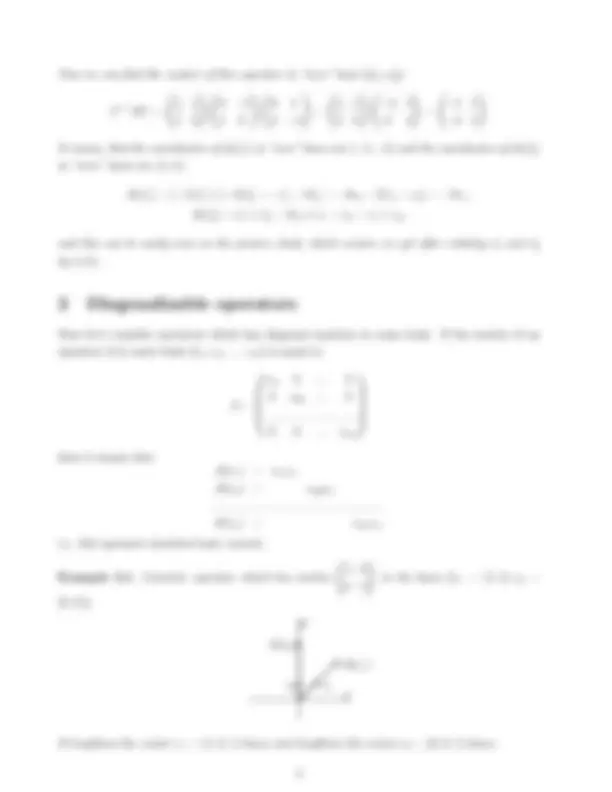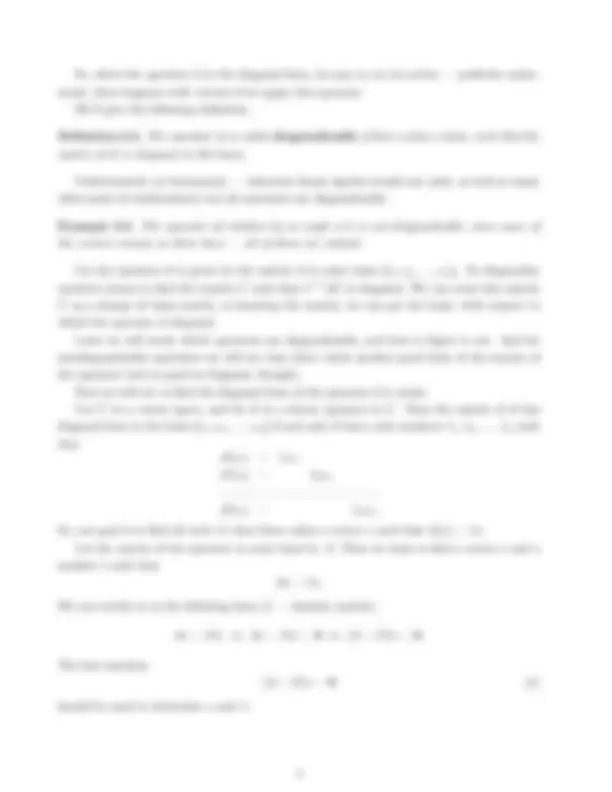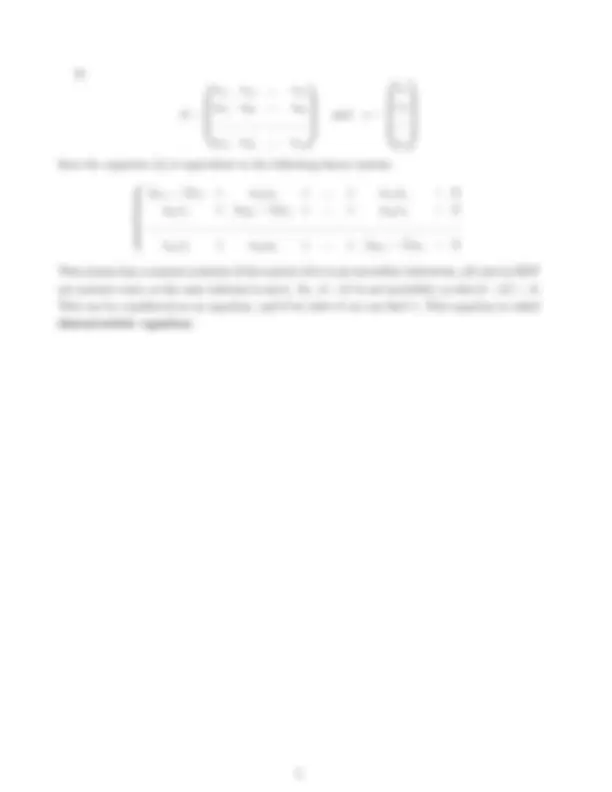





Study with the several resources on Docsity

Earn points by helping other students or get them with a premium plan


Prepare for your exams
Study with the several resources on Docsity

Earn points to download
Earn points by helping other students or get them with a premium plan
Community
Ask the community for help and clear up your study doubts
Discover the best universities in your country according to Docsity users
Free resources
Download our free guides on studying techniques, anxiety management strategies, and thesis advice from Docsity tutors
The change of matrix of a linear operator when the basis is altered. The concept of change-of-basis matrix, the relationship between the matrices of an operator in different bases, and the definition of diagonalizable operators. It also explains how to find the diagonal form of an operator if it exists.
Typology: Study notes
1 / 5

This page cannot be seen from the preview
Don't miss anything!




Last time we studied what happens with the coordinates of the vector if we change the basis from the “old” to the “new” one. We figured out that there exists a change-of-basis matrix, and if vector x had coordinates
(x 1 , x 2 ,... , xn) in the “old” basis {e 1 , e 2 ,... , en}
and coordinates (x′ 1 , x′ 2 ,... , x′ n) in the “new” basis {e′ 1 , e′ 2 ,... , e′ n}
and C is a change-of-basis matrix such that
(e′ 1 , e′ 2 ,... , e′ n) = (e 1 , e 2 ,... , en)C
then (^)
x 1 x 2 ... xn
x′ 1 x′ 2 ... x′ n
On this lecture we will study what happens with the matrix of a linear operator if we take another basis in the space. Let V be a vector space, and let {e 1 , e 2 ,... , en} be the “old” basis and {e′ 1 , e′ 2 ,... , e′ n} be the “new” basis, and the change-of-basis matrix from the “old” basis to the “new” one is C, such that (e′ 1 , e′ 2 ,... , e′ n) = (e 1 , e 2 ,... , en)C. (1)
Multiplying this equation by C−^1 we have
(e′ 1 , e′ 2 ,... , e′ n)C−^1 = (e 1 , e 2 ,... , en). (2)
Let A be a linear operator in the vector space V , and its matrix with respect to the “old” basis is A. Then by definition of the matrix of the operator,
(A(e 1 ), A(e 2 ),... , A(en)) = (e 1 , e 2 ,... , en)A. (3)
Now we can get the expression for the matrix of A is “new” basis. Applying A to both sides of the equality (1), we get
(A(e′ 1 ), A(e′ 2 ),... , A(e′ n)) = (A(e 1 ), A(e 2 ),... , A(en))C by (1) = (e 1 , e 2 ,... , en)AC by (3) = (e′ 1 , e′ 2 ,... , e′ n)C−^1 AC. by (2)
So, the matrix of this operator A in “new” basis is C−^1 AC.
Definition 1.1. Two matrices A and B are called similar if there exists a matrix C such that
B = C−^1 AC.
So, matrices of the operator in different bases are similar.
Example 1.2. Let’s consider the operator of rotation by an angle π/ 2. Let {e 1 , e 2 } be the standard basis, and the new basis is
e′ 1 = 2e 2 ; e′ 2 = e 1 − e 2.
6 y
e (^26)
e 6 ′ 1
@ @R e′ 2
Then the change-of-basis matrix is
C =
Now we can find C−^1 :
C−^1 =
2
1 2 1 0
After rotating we have:
A(e 1 ) = e 2 ; A(e 2 ) = −e 1 .,
so the matrix of this linear operator is
So, when the operator is in the diagonal form, its easy to see its action — perfectly under- stand, what happens with vectors if we apply this operator. We’ll give the following definition.
Definition 2.2. The operator A is called diagonalizable if there exists a basis, such that the matrix of A is diagonal in this basis.
Unfortunately (or fortunately — otherwise linear algebra would not exist, as well as many other parts of mathematics) not all operators are diagonalizable.
Example 2.3. The operator of rotation by an angle π/ 4 is not diagonalizable, since none of the vectors remain on their lines — all of them are rotated.
Let the operator A is given by the matrix A in some basis {e 1 , e 2 ,... , en}. To diagonalize operator means to find the matrix C such that C−^1 AC is diagonal. We can treat this matrix C as a change of basis matrix, so knowing the matrix, we can get the basis, with respect to which the operator is diagonal. Later we will study which operators are diagonalizable, and how to figure it out. And for nondiagonalizable operators we will see that there exists another good form of the matrix of the operator (not as good as diagonal, though). Now we will try to find the diagonal form of the operator if it exists. Let V be a vector space, and let A be a linear operator in V. Then the matrix of A has diagonal form in the basis {e 1 , e 2 ,... , en} if and only if there exist numbers λ 1 , λ 2 ,... , λn such that A(e 1 ) = λ 1 e 1 A(e 2 ) = λ 2 e 2
.............................. A(en) = λnen,
So, our goal is to find all such λ’s that there exists a vector x such that A(x) = λx. Let the matrix of the operator in some basis be A. Then we want to find a vector x and a number λ such that Ax = λx.
We can rewrite it in the following form (I — identity matrix):
Ax = λIx ⇔ Ax − λIx = 0 ⇔ (A − λI)x = 0.
The last equation (A − λI)x = 0 (4)
should be used to determine x and λ.
If
a 11 a 12... a 1 n a 21 a 22... a 2 n
.................. an 1 an 2... ann
and^ x^ =
x 1 x 2 ... xn
then the equation (4) is equivalent to the following linear system:
(a 11 − λ)x 1 + a 12 x 2 +... + a 1 nxn = 0 a 21 x 1 + (a 22 − λ)x 2 +... + a 2 nxn = 0
........................................................... an 1 x 1 + an 2 x 2 +... + (ann − λ)xn = 0
This system has a nonzero solution if the matrix of it is not invertible (otherwise, all rows in REF are nonzero rows, so the only solution is zero). So, A − λI is not invertible, so det(A − λI) = 0. This can be considered as an equation, and if we solve it we can find λ. This equation is called characteristic equation.